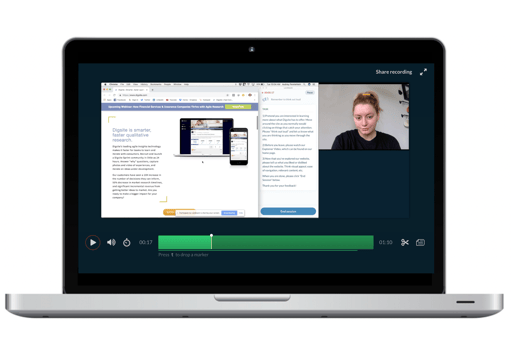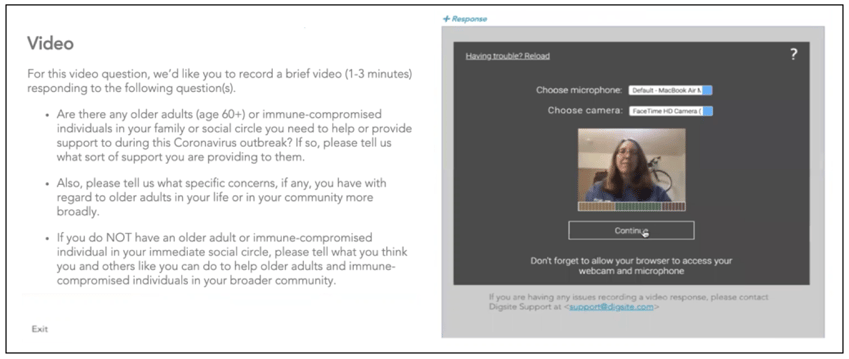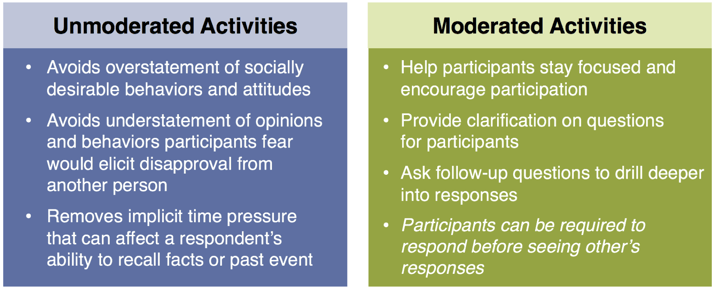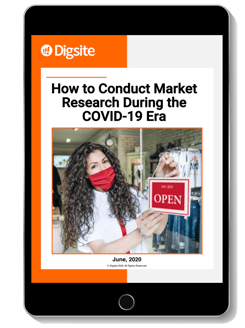Business – and the world – have changed rapidly due to the onset and spread of COVID-19. As companies worldwide consider how to operate in an environment of social distancing and remote teams, it’s no surprise that we are seeing an increased demand for online research. Companies can’t conduct in-person research or focus groups right now and need an alternative. Online qualitative research is a great one.
Online, or remote, qualitative research can work as well or better than in-person research , especially when taking advantage of new video technology. Done right, your online research should deliver:
- High-quality participants
- Strong engagement
- Rich learning
- Simplified reporting
- Fast timelines – typically 10 days start to finish
Video is a key component of online qualitative research. You can use it in different ways to achieve your specific research goals.
If you have research needs and are considering online research, these are the four top options that will help maximize your results.
1. Live, Moderated Video
Live video interviews provide many of the same benefits of in-person interviews, with the additional ability to flex between group and one-on-one interactions. For live video interviews, we typically use a consumer-friendly video platform like Zoom for a seamless research experience. The ideal platform allows for mobile and computer-based interviews, an easy-to-use app, and solid technical support when you need it.
For live discussions, we follow these best practices:
- Find the right participants. We invite consumers through our exclusive qual-only panel or use targeted social media recruiting to find harder-to-reach audiences. A short survey then screens potential participants and gauges their interest.
- Test it out. Next, we bring them into our platform and have them test the technology and answer some questions to ensure they are articulate.
- Maximize show rates. Once they’re verified as high-quality participants, we connect them to an automated scheduler to quickly and easily schedule their live interview session. Participants sign up and then receive an automatic calendar invite and text message reminders.
- Reward participation. We send participants Amazon gift cards for participating in research. These can be scheduled to be sent automatically upon completion of the video interview.
Live video sessions are automatically recorded, transcribed and timestamped. They can also be added to a video library with additional text analytics across the interviews.
Here’s an example of live video qualitative research we conducted recently: An insurance company wanted to optimize the billing and enrollment experience for its customers. Using a Digsite Sprint, the company started by conducting live video interviews on a shared screen. They went through an enrollment form step by step to see whether customers found the billing and enrollment experience easy to understand. The researchers were able to see if the customers were confused while going through a complicated document.

Next, within a dedicated online community (more on that later), they let customers mark up specific features and react to potential changes. After that exercise, they jumped back into another round of live video interviews to make sure they got everything down pat.
As a result of these activities, the insurance company was able to improve its form considerably – all in the time and cost it would take to complete just one round of traditional in-person interviews.
2. Unmoderated Video Questions
Unmoderated video is an effective way to capture consumer responses without having to be in a live session.
Video questions allow participants to share their experiences and work best when you are looking for a shorter response – typically one to three minutes in length. It’s pretty straightforward: You ask a question via text or video, and the participant replies directly with a video response.
Here’s an example from our recent COVID-19 research study: We asked all 35 participants to answer a video question about how they are helping older adults in their lives. This activity was completed overnight without having to coordinate live interview times. The Digsite team was not only able to watch those videos, but read the transcripts of the results to more quickly get a sense of how consumers were caring for older adults. We then chose seven of those participants to dive deeper in a 20-minute live video interview.
 Digsite Video Task
Digsite Video Task
3. Unmoderated Video Uploads
This option works well for longer videos and when recording an entire experience. The participant records a video on their phone and then uploads it. You can use a file-sharing system like Dropbox for the uploads if you are doing it on your own. At Digsite, we embed that capability into our platform along with video transcription and analysis.
Here’s an example of a client using an unmoderated video upload: Wisconsin-based Johnsonville was rolling out a new line of sausage products, and they wanted to make sure they were well-received. Johnsonville asked participants to capture via video how they prepared the product so they could see if they were following the instructions, how the sausage looked as it was cooking, and the reaction to the taste of the product immediately after they tried it. As a result, they found that some of the participants were preparing the products in an uncommon way. Based on that information, they followed up with participants to learn more, then enhanced their instructions to improve the experience.
Share concepts or capture online behaviors
Regardless of whether you are using live or unmoderated video, remote research enables you to share concepts, photos, ads, and more, as well as have participants share their screen and demonstrate their behaviors.
 Participant Response from Johnsonville’s Research Community
Participant Response from Johnsonville’s Research Community
Easy analysis and reporting
Uploading a set of videos into a platform with video analysis capabilities allows you to identify common keywords, phrases and themes. Clicking on a word or a phrase will surface that same word or phrase across all the participant videos. You can highlight the transcribed text and save it to a list to create a video clip reel. This makes sharing key findings faster and easier.
4. Video Plus an Online Community
While video is a primary tool for remote research, online community-style platforms like Digsite can help you layer on even more capabilities to make remote research more effective than using video alone.
Drill deeper and iterate
In this social media era, we are used to sharing about our lives and experiences. Having an online qual community where your qualitative participants go during your research can be extremely helpful. Within a community, you can drill down to smaller sub-groups and conduct live video interviews with them. You also have the opportunity to engage them after they share their video experience, which allows you to iterate and get additional feedback rapidly.

Probes and follow-ups
In an online community format, you have the capability to do probes and follow-ups. For example, if you ask participants to mark up concepts, vote on ideas or share a story, you can then probe them with follow-up questions and quickly get additional feedback as needed.
Let’s go back to the example of Johnsonville’s research on their new line of sausage products. In addition to having people prepare product, they did a number of additional activities in the Digsite community.
First, they brought a group of research participants into a Digsite community and asked them to take a photo of how the product was stored in their refrigerator and complete a survey about their product experience. They also had research participants complete fill-in-the-blank stories to delve deeper into their emotional experiences preparing and consuming the product.
As a result of these efforts, the Johnsonville team found out that one of the new sausage products didn’t fit in with the line. They went back to the drawing board and created a new flavor that made more sense.
Which Type of Research Works Best?
All these types of research have benefits. For example, with live, moderated video, you can do rapid probing and keep participants on track. With unmoderated research, the participant can respond at their own pace and avoid feeling any potential pressure or bias they may experience when in a live, moderated situation. The “right” choice generally depends on your specific research needs.

At Digsite, we are dedicated to having the latest online qualitative technology and expertise. Our experts can answer your questions and guide you as you explore your options. That’s what we do best, and during uncertain times like these, we are here to help in any way we can.
For more information on brand innovation during the COVID-19 outbreak, check out our new on-demand webinar series that features our research report on consumer shopping habits during COVID-19: How to Conduct Market Research During the COVID-19 Era.





